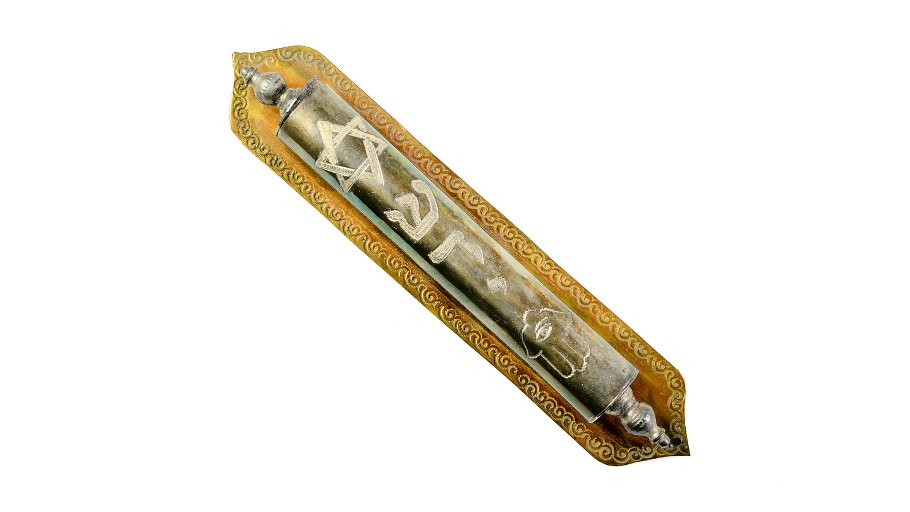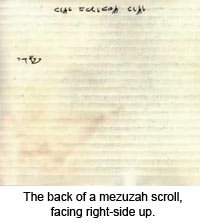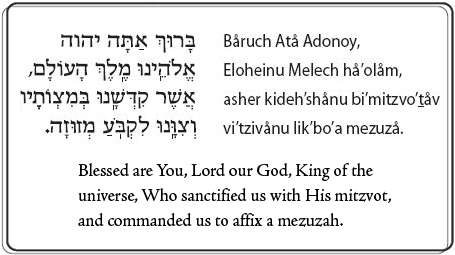 Raise a Glass to Freedom
Raise a Glass to Freedom


8 min read
The complete guide to a Jewish doorpost and how to put up a Mezuzah.
It works better than any sophisticated alarm system and is more effective than a guard dog. Mezuzah (plural: mezuzot) is an easy mitzvah to perform and may be the best way to protect yourself, your family,1 your home and all of your belongings.2
On the reverse side of the mezuzah scroll is the Hebrew name of God, Shaddai. This name is an acronym for "Guardian of the Doors of Israel." (Shin, the first letter of this Name, often appears on the mezuzah case.)
It is a foundation of Judaism that the Almighty cares about us; He wants to give us long life and protection. And as in all relationships, the more we put into it, the more we get out of it. By declaring our loyalty to God and His precepts – i.e. by protecting the mezuzah and its ideals – God will protect us in turn. In fact, fulfilling this mitzvah carries God's promise of long life.3
The mezuzah recalls the Exodus from Egypt, when the lamb's blood smeared on the doorpost "identified" the Jewish homes that God passed over during the plague of the first born.
From that day forward, the mezuzah has always identified a home as being Jewish. Traveling throughout the world, one can often seek out fellow Jews by looking for a mezuzah on the door. In areas where Jews have been exiled (e.g. Eastern Europe and Middle East countries), many doorposts still bear the mark of a mezuzah removed.
The purpose of a mezuzah is to remind us every time we pass through a doorway that God is present.4 Having a mezuzah on each room means that as we move from one domain, one sphere of activity, to another, we renew our consciousness of God's presence and act in a way that sanctifies His Name.
It is proper to place your hand on the mezuzah when passing through the entranceway,5 and then kiss the hand to demonstrate a fondness for this important mitzvah.6
Contrary to popular belief, the little rectangular box that you see on people's doorpost is not a mezuzah. That is merely a mezuzah case.
The mezuzah itself is a small scroll inscribed with two paragraphs of the Shema.7 These contain the themes of unity of God, our love for God, and the reward for mitzvot.

Since the laws of writing a mezuzah are complex, make sure that you purchase a mezuzah only from a very trustworthy source. A beautiful mezuzah case that contains a non-kosher scroll does not fulfill any mitzvah, and does not warrant the special divine protection.
A kosher mezuzah should cost $30-40. You can purchase valid scrolls online at9:
Every Jew's home must have a mezuzah. It doesn't matter whether you own the home or are renting it.10 However, if you expect to live in a place for less than 30 days, you do not need to place a mezuzah.11 In Israel, however, one is required to put up a mezuzah even for home rentals that are for less than a month.12
It is proper for Jewish institutions (e.g. synagogues) to have mezuzot, even though some may be technically exempt.13 A car does not require a mezuzah. A sukkah is considered a temporary dwelling and does not require a mezuzah.14
When a Jew and non-Jew share a house, each having his own designated room or area, then a mezuzah is not posted on the common doorway.15
Placing a single mezuzah on your front door is a good start, but it does not suffice. Rather, every entranceway of your home should have its own mezuzah.16 Therefore, a Jewish home typically has mezuzot also on the side doors, porch, bedrooms, living room, playroom, garage (if used for storage), laundry room, etc.
Even if a doorway does not contain a door (for example, it is an archway), it still requires a mezuzah.17 However, a mezuzah should not be put on a bathroom, as that is considered disrespectful.18
The mezuzah should be placed on the doorpost where the lintel is directly above it.19 If the doorway is deep, the mezuzah should be placed on the doorpost within 3 inches of the entrance.20 If the doorway has little depth, i.e. it is not possible to place the mezuzah on the doorpost within the doorway itself, then the mezuzah may be placed on the outer part of the doorpost, within 3 inches of the doorway.21
The mezuzah should be placed at shoulder height.22 On a typical doorway, it would be at the low end of the top third.23 The mezuzah is always affixed to the doorpost that is on the right side when you are entering the house/room.24
Sefardim affix the mezuzah so that it is vertical. The Ashkenazi custom is to put it on a diagonal, with the top of the mezuzah facing inward.25
 Once you have a mezuzah, here's how to roll it up:
Once you have a mezuzah, here's how to roll it up:
1) Place the parchment in front of you so the text of the "Shema" is facing you.
2) The mezuzah is rolled, not folded. Begin to roll from the left side (i.e. from the end of the Hebrew text), so that the words are on the inside.
3) Be careful to roll smoothly and do not crease the parchment. Scratching off any ink renders the mezuzah invalid.
4) The rolled mezuzah is then wrapped in a protective covering, with the wrapping only around the outside of the mezuzah (i.e. not in-between the rolling). It is best to wrap the parchment in a material that breathes, like wax paper. Plastic wrap makes the parchment sweat and could destroy the letters, especially if the mezuzah is placed outside.
Wrapping the mezuzah is not a requirement. For aesthetic reasons you may prefer to leave it unwrapped, for example if your mezuzah case is a see-through material like glass.
When placing the mezuzah in the case and on the wall, be sure that the Hebrew word "Shaddai," which is written on the back of the parchment, is facing outward (i.e. away from the lintel, once it is affixed).26 Also, make sure the mezuzah is not upside down!27
The mezuzah should be permanently affixed with glue, silicon, nails or screws. Tape that would fall off if bumped into is too temporary to be considered "affixed." Similarly, velcro and magnets should not be used.28
Once the mezuzah is in position, but before affixing it to the door, say the following blessing:29

If you are putting up many mezuzot at one time, one blessing suffices for all of them.30 But be careful not to speak unnecessarily until the last mezuzah is up.31
When moisture, dust or paint penetrates a mezuzah, it can sometimes ruin it. Thus it is important to have your mezuzah inspected by an expert scribe every 3 or 4 years.32 If a mezuzah is placed in a glass, moisture-resistant case, inspection is not necessary unless there is reason to suspect a problem.33
When moving out of a home – and the next occupant is also Jewish – it is considered disrespectful to remove the mezuzot.34 But as there is a significant expense involved (since one house could have many mezuzot), it is appropriate for the new occupants to pay for the mezuzot,35 or alternatively to offer to put up their own.36
View this post on Instagram
